Reading: Postwar Challenges
Postwar Challenges
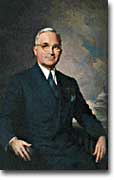
When he became President upon Franklin D. Roosevelt's death in 1945, few believed in Harry Truman's ability to govern. But it was Truman's common sense approach that helped the U.S. end World War II and move on to tackle postwar challenges.
Euphoria.
When Japan surrendered to the Allies at the end of the long summer of 1945, Americans were ecstatic. Ticker tape parades were staged in nearly every town to welcome America's returning heroes.
Unquestionably, the United States entry in World War II made the difference for the Allied cause. The American army and navy were now the most powerful in the world. Even those who did not fight could feel proud of the work Americans did in the factories to build the war machine.
The youth of America would never forget the sacrifices of wartime. From rationing food to collecting scrap to buying bonds to fighting in battle, the efforts to defeat the Axis were a product of the collective American will. News anchor, Tom Brokaw, recently labeled the Americans who came of age in World War II the "greatest generation."
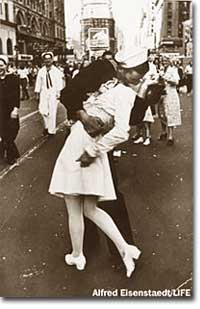
The euphoria that swept the nation in 1945 was captured on film by Lifemagazine photographer Alfred Eisenstaedt. This memorable image of a sailor kissing a nurse in Times Square continues to be a defining image of WWII.
Unfortunately, the euphoria could not last long. Although the Soviet Union and the United States were allied in their struggle against Hitler's Germany, Americans distrusted Josef Stalin's Communist government and abhorred his takeover of Eastern European countries immediately after the war. More Soviet citizens were killed in World War II than any other nation, and Josef Stalin was determined to receive compensation for damages and guarantees that such a slaughter could never again plague the Soviet people.
For its part, the United States was unwilling to sit idle while another form of totalitarianism spread westward from Moscow. One war immediately begat another — the COLD WAR.
No theater of the globe was free from Cold War struggle. From Eastern Europe to China and Korea, the Truman Administration was beset with the challenge of halting the advance of communism. As the wave of decolonization washed through the southern part of the globe, each new nation would be courted by the superpowers. TheINDEPENDENCE OF ISRAEL IN 1948 had Cold War implications in the Middle East. Within five years of the end of World War II, American troops were summoned to South Korea to halt the advancing communist forces of the North.
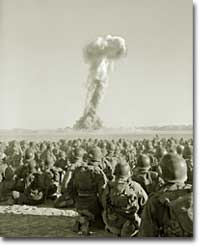
The American military prepared for the Cold War by conducting tests with new atomic and nuclear technology. Here, troops watch radioactive smoke during the "Desert Rock" exercise in 1951.
No single foreign policy issue mattered more to the United States for the next 50 years as much as the Cold War. President Truman set the direction for the next eight presidents with the announcement of the containment policy. Crises in Berlin, China, and Korea forced Truman to back his words with actions. The Cold War kept defense industries humming and ultimately proved the limits of American power in Vietnam. Democracy was tested with outbreaks of Communist witch hunts.
Although the United States would emerge triumphant in the Cold War, the last half of the 1940s was marked by an uncertainty that soured the sweet taste of victory in World War II.
The Cold War Erupts
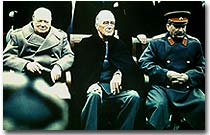
Prime Minister Churchill, President Roosevelt, and Premier Stalin meet at Yalta to discuss post-war Europe. It was at both the Yalta and Dumbarton Oaks conferences that the framework for the United Nations was devised.
In 1945, one major war ended and another began.
The Cold War lasted about 45 years. There were no direct military campaigns between the two main antagonists, the United States and the Soviet Union. Yet billions of dollars and millions of lives were lost in the fight.
The United States became the leader of the free-market capitalist world. America and its allies struggled to keep the communist, totalitarian Soviet Union from expanding into Europe, Asia, and Africa. Theaters as remote as Korea and Vietnam, Cuba and Grenada, Afghanistan and Angola, became battlegrounds between the two ideologies. One postwar pattern quickly became clear. The United States would not retreat into its former isolationist stance as long as there was a Cold War to wage.
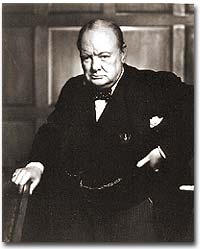
Winston Churchill's 1946 speech to Westminster University in Missouri contained the first reference to the communism of Eastern Europe as an "iron curtain."
The long-term causes of the Cold War are clear. Western democracies had always been hostile to the idea of a communist state. The United States had refused recognition to the USSR for 16 years after the Bolshevik takeover. Domestic fears of communism erupted in a RED SCARE in America in the early Twenties. American business leaders had long feared the consequences of a politically driven workers' organization. World War II provided short-term causes as well.
There was hostility on the Soviet side as well. Twenty million Russian citizens perished during World War II. Stalin was enraged that the Americans and British had waited so long to open a front in France. This would have relieved pressure on the Soviet Union from the attacking Germans. Further, The United States terminated Lend-Lease aid to the Soviet Union before the war was complete. Finally, the Soviet Union believed in communism.
Stalin made promises during the war about the freedom of eastern Europe on which he blatantly reneged. At the YALTA CONFERENCE, the USSR pledged to enter the war against Japan no later than three months after the conclusion of the European war. In return, the United States awarded the Soviets territorial concessions from Japan and special rights in Chinese Manchuria.
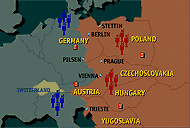 This map depicts the situation in Europe around the time of V-E Day. Soviet troops (in red) were able to secure Eastern Europe, while the other Allies worked to win the West. |
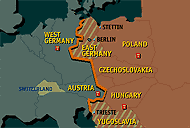 Europe in 1946 was becoming increasingly divided by the "iron curtain" seen in this map. Countries to the east of the orange line remained — or became — communist following World War II. |
When the Soviet Union entered the war between the bombings of Hiroshima and Nagasaki, the United States no longer needed their aid, but Stalin was there to collect on Western promises. All these factors contributed to a climate of mistrust that heightened tensions at the outbreak of the Cold War.
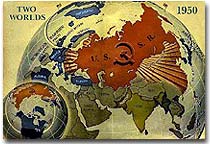
For most of the second half of the 20th century, the USSR and the United States were engaged in a Cold War of economic and diplomatic struggles. The communist bloc, as it appeared in 1950, included countries to the west and southeast of the Soviet Union.
At Potsdam, the Allies agreed on the postwar outcome for Nazi Germany. After territorial adjustments, Germany was divided into four OCCUPATION ZONESwith the United States, Great Britain, France, and the Soviet Union each administering one. Germany was to be democratized and de-Nazified. Once the Nazi leaders were arrested and war crimes trials began, a date would be agreed upon for the election of a new German government and the withdrawal of Allied troops.
This process was executed in the zones held by the western Allies. In the eastern Soviet occupation zone, a puppet communist regime was elected. There was no promise of repatriation with the west. Soon such governments, aided by the Soviet Red Army came to power all across eastern Europe. Stalin was determined to create a buffer zone to prevent any future invasion of the Russian heartland.
Winston Churchill remarked in 1946 that an "iron curtain had descended across the continent."
The United Nations
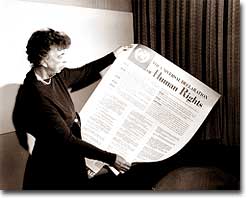
Eleanor Roosevelt became head of the UN's Commission on Human Rights in 1946. Here she holds a copy of the "Declaration of Human Rights," which she considered to be her greatest achievement.
The Allies had won the war, but would they be able to keep the peace?
An examination of the period between WWI and WWII showed a lack of commitment to the spirit of internationalism. The old League of Nations proved too weak in structure to fill this void. Perhaps a stronger international body, as envisioned by Woodrow Wilson, was necessary to keep the world powers from tearing each other apart. It was in this spirit that Franklin Roosevelt championed the creation of a United Nations.
The BIG THREE of Churchill, Roosevelt, and Stalin had devoted hours of dialogue to the nature of a United Nations. After agreeing on the general principles at the DUMBARTON OAKS and Yalta Conferences, delegates from around the world met in San Francisco to write a charter. With the nation still mourning the recent death of Franklin Roosevelt, his wife Eleanor addressed the delegates. Despite considerable enmity and conflicts of interest among the attending nations, a charter was ultimately approved by unanimous consent.
Despite the ideological animosity spawned by the Cold War, a new spirit of globalism was born after WWII. It was based, in part, on the widespread recognition of the failures of isolationism. The incarnation of this global sprit came to life with the establishment of the United Nations in 1945 with its headquarters in New York City.
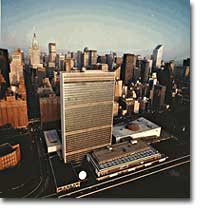
The United Nations headquarters complex, consisting of four buildings, occupies 18 acres in New York City.
How does the UN work?
The UN charter called for the establishment of a Security Council, or "upper house." The SECURITY COUNCILserves as the executive branch of the United Nations. The Security Council must authorize any actions, such as economic sanctions, the use of force, or the deployment of peacekeeping troops.
Each of the "GREAT POWERS" — the United States, Great Britain, France, China, and the Soviet Union — holds a permanent seat on the Security Council. The remaining ten seats are elected to two-year terms by the General Assembly. Each permanent member holds the power of veto. No action can go forth if any one of the five objects. As the Cold War crystallized, the countervailing veto powers of the United States and the Soviet Union served often to inhibit the Security Council from taking any forceful or meaningful action.
The main body of the United Nations is called the GENERAL ASSEMBLY. Every member nation holds a seat in the General Assembly, which is often described as a town meeting for the world. The General Assembly has standing committees to address ongoing issues such as economics and finance, social, cultural and humanitarian concerns, and legal problems. The General Assembly passes resolutions and has the power to make recommendations to the Security Council, but has no power to require any action. In addition to the General Assembly, and ECONOMIC AND SOCIAL COUNCIL has committees designed to address a wide array of topics from the STATUS OF WOMEN to theENVIRONMENT.
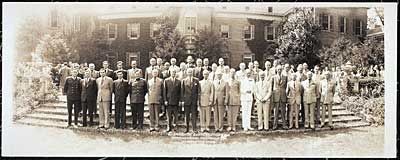
World leaders met at Dumbarton Oaks, Washington, D.C., in August 1944 to formulate plans for a new organization to promote international cooperation. The general principles established there provided the foundation for the United Nations charter.
A TRUSTEESHIP COUNCIL was designed to oversee the transition of states from colonies to independent nations.
The Secretariat manages the day-to-day operations of the United Nations. AnINTERNATIONAL COURT OF JUSTICE was also created.
The UN can point to many solid accomplishments. Among them: sending peacekeepers to war-stricken areas, making recommendations on how to raise literacy and health rates in the Third World, and even authorizing the use of force against aggressor nations.
In 1945 as well as today the UN gives cause for believe that nations can get along together. In a world with conflicting histories, agendas, and political posturing, one international group — the United Nations — remains above the day-to-day fray.
When the Cold War ended in the 1990s, many citizens around the globe once again looked to the United Nations with renewed hope of building a safer, stronger planet.
Containment and the Marshall Plan
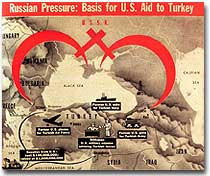
This illustration from the July 16, 1948, U.S. News magazine shows the beginnings of American containment policy. The U.S. is seen sending troops, advisors and weapons to Turkey in hopes that the country will resist communism and remain democratic.
Communism was on the march.
When the RED ARMY marched on Germany, it quickly absorbed the nearby nations ESTONIA, LATVIA, AND LITHUANIAinto the Soviet Union. Soon communist forces dominated the governments ofROMANIA and BULGARIA. By the fall of 1945, it was clear that the Soviet-backed LUBLIN REGIME had complete control of Poland, violating the Yalta promise of free and unfettered elections there. It was only a matter of time before Hungary and Czechoslovakia fell into the Soviet orbit. Yugoslavia had an independent communist leader namedTITO.
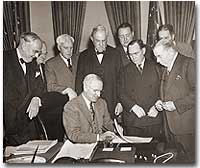
When Harry Truman approved the Marshall Plan in 1948, his official statement said, "Few presidents have had the opportunity to sign legislation of such importance."
And now Stalin was ordering the creation of a communist PUPPET REGIME in the Soviet sector of occupied Germany. How many dominoes would fall? United States diplomats saw a continent ravaged by war looking for strong leadership and aid of any sort, providing a climate ripe for revolution. Would the Soviets get all of Germany? Or Italy and France? President Truman was determined to reverse this trend.
Greece and Turkey were the first nations spiraling into crisis that had not been directly occupied by the Soviet Army. Both countries were on the verge of being taken over by Soviet-backed guerrilla movements. Truman decided to draw a line in the sand. In March 1947, he asked Congress to appropriate $400 million to send to these two nations in the form of military and economic assistance. Within two years the communist threat had passed, and both nations were comfortably in the western sphere of influence.
A mid-level diplomat in the State Department named GEORGE KENNANproposed the POLICY OF CONTAINMENT. Since the American people were weary from war and had no desire to send United States troops into Eastern Europe, rolling back the gains of the Red Army would have been impossible.
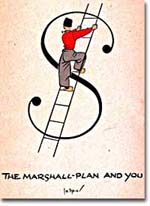
In July 1947 a majority of the American public had never even heard of the Marshall Plan. But to win passage in Congress, the Truman administration needed strong public support, so it launched a massive public relations campaign.
But in places where communism threatened to expand, American aid might prevent a takeover. By vigorously pursuing this policy, the United States might be able to contain communism within its current borders. The policy became known as the TRUMAN DOCTRINE, as the President outlined these intentions with his request for monetary aid for Greece and Turkey.
In the aftermath of WWII, Western Europe lay devastated. The war had ruined crop fields and destroyed infrastructure, leaving most of Europe in dire need. On June 5, 1947, Secretary of StateGEORGE MARSHALL announced the European Recovery Program. To avoid antagonizing the Soviet Union, Marshall announced that the purpose of sending aid to Western Europe was completely humanitarian, and even offered aid to the communist states in the east. Congress approved Truman's request of $17 billion over four years to be sent to Great Britain, France, West Germany, Italy, the Netherlands and Belgium.
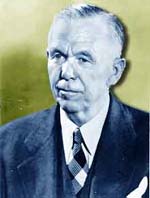
In a speech to Harvard University in 1947, Secretary of State George C. Marshall proposed that a post-war European aid program be initiated. Less than a year later, the Marshall Plan was a reality.
The MARSHALL PLAN created an economic miracle in Western Europe. By the target date of the program four years later, Western European industries were producing twice as much as they had been the year before war broke out. Some Americans grumbled about the costs, but the nation spent more on liquor during the years of the Marshall Plan than they sent overseas to Europe. The aid also produced record levels of trade with American firms, fueling a postwar economic boom in the United States.
Lastly and much to Truman's delight, none of these nations of western Europe faced a serious threat of communist takeover for the duration of the Cold War.
The Berlin Airlift and NATO
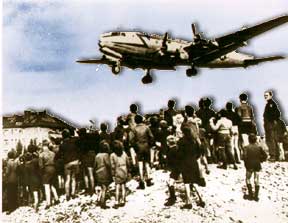
Many gather to watch a C-54 loaded with supplies land at Tempelhof airfield in the U.S. sector of Berlin. Over the 11 month course of the Airlift, nearly 4000 tons of goods were delivered every day.
BERLIN, Germany's wartime capital was the prickliest of all issues that separated the United States and Soviet Union during the late 1940s. The city was divided into four ZONES OF OCCUPATION like the rest of Germany. However, the entire city lay within the Soviet zone of occupation. Once the nation of EAST GERMANY was established, the Allied sections of the capital known as West Berlin became an island of democracy and capitalism behind the IRON CURTAIN.
In June 1948, tensions within Berlin touched off a crisis.
The Soviets decided to seal all land routes going into West Berlin. Stalin gambled that the Western powers were not willing to risk another war to protect half of Berlin. The Allies were tired, and their populations were unlikely to support a new war. A withdrawal by the United States would eliminate this democratic enclave in the Soviet zone.
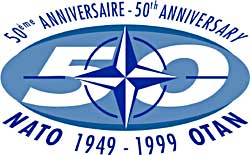
The North Atlantic Treaty Organization celebrated an important milestone in 1999. For over 50 years now, NATO has existed as a symbol of the solidarity of Western nations.
Truman was faced with tough choices. Relinquishing Berlin to the Soviets would seriously undermine the new doctrine of containment. Any negotiated settlement would suggest that the USSR could engineer a crisis at any time to exact concessions. If Berlin were compromised, the whole of West Germany might question the American commitment to German democracy. To Harry Truman, there was no question. "We are going to stay, period, " he declared. Together, with Britain, the United States began moving massive amounts of food and supplies into West Berlin by the only path still open — the air.
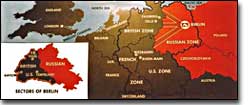
Flying from occupied Germany and landing a supply plane in Berlin at the rate of one every 3 minutes, the Berlin Airlift managed to supply the city with the materials needed for survival.
Truman had thrown the gauntlet at Stalin's feet. The USSR had to now choose between war and peace. He refused to give the order to shoot down the American planes. Over the next eleven months, British and American planes flew over 4000 tons of supplies daily into West Berlin. As the American public cheered "OPERATION VITTLES," Stalin began to look bad in the eyes of the world. He was clearly willing to use innocent civilians as pawns to quench his expansionist thirst. In May 1949, the Soviets ended the blockade. The United States and Britain had flown over 250,000-supply missions.
Stalin miscalculated when he estimated the strength of western unity. To cement the cooperation that the western allies had shown during the war and immediate postwar years, the NORTH ATLANTIC TREATY ORGANIZATION was created in April 1949. The pact operated on the basis of collective security. If any one of the member states were attacked, all would retaliate together. The original NATO included Britain, France, Italy, the Netherlands, Belgium, Canada, Iceland, Luxembourg, Denmark, Norway, Portugal, and the United States.
NATO was the very sort of permanent alliance GEORGE WASHINGTON warned against in his FAREWELL ADDRESS, and represented the first such agreement since the FRANCO-AMERICAN ALLIANCE that helped secure victory in theAMERICAN REVOLUTION.
The United States formally shed its ISOLATIONIST past and thrust itself forward as a determined superpower fighting its new rival.
The Korean War
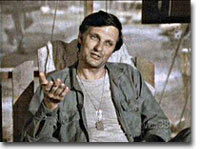
The television show "M*A*S*H" aired from 1972-83 and used a Korean War innovation — the Mobile Army Surgical Hospital — as its setting. The shows characters, like Dr. "Hawkeye" Pierce, often addressed the tough issues of war through their interactions.
While many of us have probably seen episodes of the TV show "M*A*S*H," few of us could explain what caused the Korean War. Here's a chance to understand what "Dr. Benjamin Franklin ("Hawkeye") Pierce from Crabapple Cove, Maine, was doing in Korea.
Containment had not gone so well in Asia. When the Soviet Union entered the war against Japan, they sent troops into Japanese-occupied Korea. As American troops established a presence in the southern part of the Korean peninsula, the Soviets began cutting roads and communications at the 38TH PARALLEL. Two separate governments were emerging, as Korea began to resemble the divided Germany.
Upon the recommendation of the UN, elections were scheduled, but the North refused to participate. The South elected SYNGMAN RHEE as president, but the Soviet-backed North was ruled by KIM IL SUNG. When the United States withdrew its forces from the peninsula, trouble began.
Northern Korean armed forces crossed the 38th parallel on June 25, 1950. It took only two days for President Truman to commit the United States military to the defense of southern Korea. Truman hoped to build a broad coalition against the aggressors from the North by enlisting support from the United Nations.
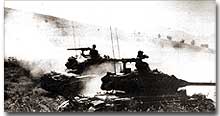
North Korean tanks cross the 38th Parallel, marking the opening salvo of the Korean War.
Of course, the Soviet Union could veto any proposed action by the Security Council, but this time, the Americans were in luck. The Soviets were boycotting the Security Council for refusing to admit RED CHINA into the United Nations. As a result, the Council voted unanimously to "repel the armed attack" of North Korea. Many countries sent troops to defend the South, but forces beyond those of the United States and South Korea were nominal.
The commander of the UN forces was none other than Douglas MacArthur. He had an uphill battle to fight, as the North had overrun the entire peninsula with the exception of the small PUSAN PERIMETER in the South. MacArthur ordered an amphibious assault at Inchon on the western side of the peninsula on September 15.
Caught by surprise, the communist-backed northern forces reeled in retreat. American led-forces from INCHON and the Pusan Perimeter quickly pushed the northern troops to the 38th Parallel — and kept going. The United States saw an opportunity to create a complete indivisible democratic Korea and pushed the northern army up to the Yalu River, which borders China.
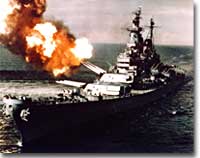
The USS Missouri fires on Chongjin, North Korea, in October 1950. The mission of this particular engagement was to disable enemy communications systems.
With anticommunism on the rise at home, Truman relished the idea of reuniting Korea. His hopes were dashed on November 27, when over 400,000 Chinese soldiers flooded across the YALU RIVER. In 1949, Mao Tse-tung had established a communist dictatorship in China, the world's most populous nation. The Chinese now sought to aide the communists in northern Korea.
In no time, American troops were once again forced below the 38th Parallel. General MacArthur wanted to escalate the war. He sought to bomb the Chinese mainland and blockade their coast.
Truman disagreed. He feared escalation of the conflict could lead to World War III, especially if the now nuclear-armed Soviet Union lent assistance to China. Disgruntled, MacArthur took his case directly to the American people by openly criticizing Truman's approach. Truman promptly fired him for insubordination.
Meanwhile, the war evolved into a stalemate, with the front line corresponding more or less to the 38th Parallel. Ceasefire negotiations dragged on for two more years, beyond Truman's Presidency. Finally, on July 27, 1953, an armistice was signed at PANMUNJOM. North Korea remained a communist dictatorship, and South Korea remained under the control of Syngman Rhee, a military strong man. Over 53,000 Americans were killed in the conflict.
Domestic Challenges
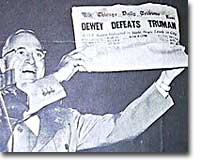
The 1948 Presidential election pitted Democrat Harry Truman against Republican Thomas Dewey. TheChicago Daily Tribune was so confident Truman was headed for defeat that they printed this headline before all of the votes had been counted.
The sign on Harry Truman's desk read "THE BUCK STOPS HERE." By buck, he meant responsibility, and the bucks ran amuck on his desk.
The end of World War II brought a series of challenges to Harry Truman. The entire economy had to be converted from a wartime economy to a consumer economy. Strikes that had been delayed during the war erupted with a frenzy across America. Inflation threatened as millions of Americans planned to spend wealth they had not enjoyed since 1929. As the soldiers returned home, they wanted their old jobs back, creating a huge labor surplus. Truman, distracted by new threats overseas, was faced with additional crises at home.
To provide relief for the veterans of World War II, and to diminish the labor surplus, Congress passed the SERVICEMAN'S READJUSTMENT ACT OF 1944. Known as the GI BILL OF RIGHTS, this law granted government loans to veterans who wished to start a new business or build a home. It also provided money for veterans to attend school or college. Thousands took advantage, and Americans enjoyed the double bonus of relieving unemployment and investing in a more educated workforce.
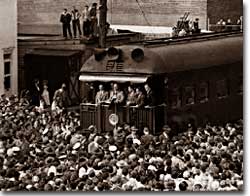
Harry Truman was elected in 1948, a feat that few political experts had thought possible. To bolster his chances, Truman took to the rails and ran a "whistle-stop" campaign, speaking in over 200 towns in the weeks leading up to the election.
Although Truman maintained wartime price controls for over a year after the war, he was pressured to end them by the Republican Congress in 1947. Inflation skyrocketed and workers immediately demanded pay increases. Strikes soon spread across America involving millions of American workers.
Congress passed the TAFT-HARTLEY ACT, which allowed the President to declare a "cooling-off" period if a strike were to erupt. Union leaders became liable for damages in lawsuits and were required to sign noncommunist oaths. The ability of unions to contribute to political campaigns was limited. Truman vetoed this measure, but it was passed by the Congress nonetheless.
Serious issues remained. Now that nuclear power was a reality, who would control the fissionable materials? In August 1946, Truman signed the ATOMIC ENERGY ACT, which gave the government a monopoly over all nuclear material. Five civilians would head the ATOMIC ENERGY COMMISSION. They directed the peaceful uses of the atom. The President was vested with exclusive authority to launch a NUCLEAR STRIKE. The military was also reorganized.
The WAR DEPARTMENT was eliminated and a new DEFENSE DEPARTMENT was created. The Secretaries of the Army, Navy, and Air Force were subordinate to the new Secretary of Defense. The NATIONAL SECURITY COUNCIL was created to coordinate the Departments of State and Defense. Finally, a CENTRAL INTELLIGENCE AGENCY was established to monitor espionage activities around the globe.

Harry Truman kept this sign on his desk to make it known that he would not be "passing the buck" on to anyone else.
In 1948, Harry Truman faced reelection. Almost every political spin-doctor in the nation predicted a victory by the Republican Governor of New York,THOMAS DEWEY. The Democratic Party was split three ways. In addition to Truman, HENRY WALLACE represented the liberal wing on the Progressive Party ticket. J. STROM THURMOND ran as a "DIXIECRAT" Southern candidate who thought Truman too liberal on civil rights.
Truman ran a whistle-stop train campaign across the land, hoping to win by holding onto the Solid South and retaining the support of organized labor. He also became the first candidate to campaign openly for the African American vote. Against everyone's predictions but his own, Truman prevailed on election day. He had hoped to enact a socially expansive FAIR DEAL, much along the lines of the New Deal of FDR, but conservative Democrats and Republicans in the Congress blocked most of his initiatives.
Of the Presidency Truman wrote, "The President — whoever he is — has to decide. He can't pass the buck to anybody. No one else can do the deciding for him. That's his job."
